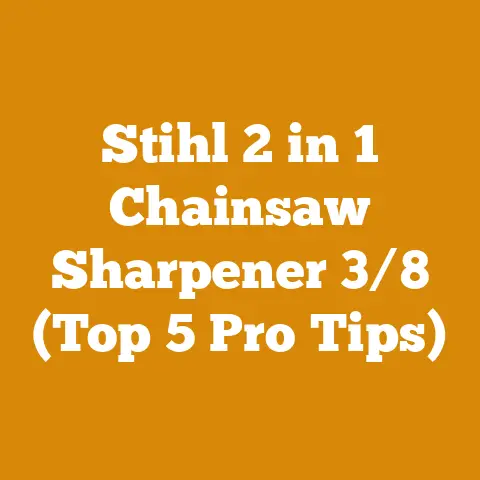Straight or Curved Weed Eater: Wood Processing Tips (7 Pro Tricks)
“I’m just starting out with managing my property, and I’m drowning in weeds and small saplings. Someone told me a weed eater could help with more than just grass. But then I saw some are straight and some are curved. What’s the deal, and can a weed eater really help with wood processing?”
That’s a question I hear all the time, and it’s a valid one. While a “weed eater” (more accurately called a string trimmer or brush cutter) isn’t going to be your primary wood processing tool like a chainsaw or a log splitter, it can be incredibly useful for specific tasks. The choice between a straight shaft and a curved shaft trimmer, along with the right attachments and techniques, can make a significant difference. Let’s dive into how you can leverage a weed eater for wood processing, along with those “7 Pro Tricks” I promised.
Weed Eaters and Wood Processing: Beyond the Lawn
Most people think of weed eaters as tools solely for trimming grass along sidewalks and flowerbeds. However, with the right attachments and techniques, they can be surprisingly effective for certain wood processing tasks, especially dealing with smaller diameter wood and vegetation. Think of it as an extension of your landscaping and property management toolkit, bridging the gap between lawn care and light forestry work.
Key Terms and Concepts
Before we get started, let’s define some key terms to ensure we’re all on the same page:
- String Trimmer (Weed Eater): A tool that uses a rotating head with nylon string to cut vegetation. Primarily used for grass and light weeds.
- Brush Cutter: A heavier-duty version of a string trimmer, often with a straight shaft and the ability to accept metal blades for cutting thicker vegetation, including small trees and saplings.
- Green Wood: Wood that has been freshly cut and has a high moisture content. It’s generally easier to split than seasoned wood but more prone to warping and fungal growth.
- Seasoned Wood: Wood that has been dried to reduce its moisture content. Seasoned wood burns more efficiently in a fireplace or wood stove.
- Kerf: The width of the cut made by a saw blade or, in this case, a brush cutter blade.
Straight Shaft vs. Curved Shaft: Which is Right for Wood Processing?
The first decision you’ll need to make is whether to use a straight shaft or a curved shaft trimmer. While both can cut vegetation, they have different strengths and weaknesses.
Curved Shaft Trimmers
- Pros:
- Lighter and Easier to Maneuver: Curved shaft trimmers are generally lighter and easier to handle, especially for extended periods. This makes them ideal for trimming grass and light weeds.
- Lower Cost: Curved shaft trimmers are typically less expensive than straight shaft models.
- Cons:
- Less Power: Curved shaft trimmers often have less powerful engines and are not designed for heavy-duty work.
- Limited Reach: The curved shaft limits your reach, making it difficult to trim under bushes or in tight spaces.
- Attachment Limitations: Curved shaft trimmers often have limited attachment options, making them less versatile for wood processing tasks.
- My Experience: I started with a curved shaft trimmer for basic lawn care. It was great for edging, but when I tried to tackle thicker weeds and small saplings, it quickly became underpowered and frustrating.
Straight Shaft Trimmers
- Pros:
- More Power: Straight shaft trimmers typically have more powerful engines, making them suitable for heavier-duty work.
- Greater Reach: The straight shaft allows you to reach under bushes and in tight spaces more easily.
- Attachment Versatility: Straight shaft trimmers can accept a wider range of attachments, including metal blades for cutting thicker vegetation.
- Better Ergonomics (for some): While heavier, the straight shaft allows for a more natural, upright posture, which can reduce back strain over time, especially when paired with a good harness.
- Cons:
- Heavier and More Difficult to Maneuver: Straight shaft trimmers are heavier and can be more challenging to handle, especially for extended periods.
- Higher Cost: Straight shaft trimmers are typically more expensive than curved shaft models.
For wood processing, a straight shaft trimmer is almost always the better choice. The increased power and attachment versatility are essential for tackling thicker vegetation and small trees.
7 Pro Tricks for Wood Processing with a Weed Eater
Now, let’s get to those “7 Pro Tricks” for using a weed eater for wood processing:
1. Choose the Right Attachment
The key to effectively using a weed eater for wood processing is selecting the right attachment. The standard nylon string head is only suitable for grass and light weeds. For anything thicker, you’ll need a metal blade.
- Brush Blades: These are circular blades with teeth designed for cutting thicker vegetation, including small trees and saplings. They come in various sizes and tooth configurations. A blade with fewer, larger teeth is generally better for cutting thicker material, while a blade with more, smaller teeth is better for finer work.
- Chainsaw Attachments: Some straight shaft trimmers can accept chainsaw attachments, which essentially turn the trimmer into a mini-chainsaw. These are ideal for pruning branches and cutting small logs. Note: Use these with extreme caution and only if you are experienced with chainsaws.
- My Experience: I’ve found that a brush blade with 80 teeth is a good all-around choice for most wood processing tasks. It’s aggressive enough to cut through small saplings but still precise enough for trimming around delicate plants.
2. Sharpen Your Blades Regularly
A dull blade is not only less effective but also more dangerous. It requires more force to cut, increasing the risk of kickback and injury. Sharpen your blades regularly using a file or a grinding wheel.
- Frequency: How often you need to sharpen your blade depends on the type of vegetation you’re cutting and the amount of use. As a general rule, sharpen your blade after every 4-6 hours of use, or whenever you notice it’s becoming less effective.
- Technique: Use a file to sharpen the cutting edges of the teeth. Follow the original angle of the teeth. Be careful not to overheat the blade, as this can damage the metal.
- Safety: Always wear safety glasses and gloves when sharpening blades.
3. Use Proper Cutting Techniques
When cutting thicker vegetation, don’t try to cut through it in one pass. Instead, use a sweeping motion, gradually cutting deeper with each pass. This reduces the risk of kickback and allows the blade to work more efficiently.
- Direction: Cut in a direction away from your body to avoid being struck by debris.
- Angle: Hold the trimmer at a slight angle to the vegetation to allow the blade to bite into the wood more easily.
- Avoid Kickback: Be especially careful when cutting near the ground, as the blade can kick back if it hits a rock or other obstacle.
4. Clear Debris Regularly
As you cut, debris will accumulate around the blade. This can reduce the blade’s effectiveness and increase the risk of kickback. Clear debris regularly using a stick or your gloved hand.
- Frequency: Clear debris every few minutes, or whenever you notice it’s accumulating around the blade.
- Safety: Always stop the engine before clearing debris.
- My Experience: I once spent an hour trying to cut through a thick patch of weeds with a dull blade and a clogged trimmer head. It was frustrating and exhausting. Now, I make sure to sharpen my blade and clear debris regularly, and it makes a world of difference.
5. Protect Yourself with Proper Safety Gear
Wood processing can be dangerous, so it’s essential to wear proper safety gear. This includes:
- Safety Glasses or Face Shield: To protect your eyes from flying debris.
- Hearing Protection: To protect your ears from the loud noise of the engine.
- Gloves: To protect your hands from cuts and abrasions.
- Long Pants and Sleeves: To protect your skin from scratches and insect bites.
- Steel-Toed Boots: To protect your feet from falling objects and sharp objects on the ground.
- Chaps: Specifically designed for chainsaw/brush cutter use, to protect your legs.
- Helmet: Provides crucial head protection.
6. Use a Harness for Extended Use
Straight shaft trimmers can be heavy, and using them for extended periods can lead to fatigue and back pain. A harness distributes the weight of the trimmer more evenly, reducing strain on your body.
- Types of Harnesses: There are several types of harnesses available, including shoulder harnesses and full-body harnesses. Choose a harness that is comfortable and fits properly.
- Adjustment: Adjust the harness so that the trimmer hangs at a comfortable height and angle.
- My Experience: I used to think harnesses were unnecessary, but after a few hours of clearing brush on a hillside, my back was killing me. Now, I always use a harness when using my straight shaft trimmer for extended periods. It makes a huge difference in my comfort and productivity.
7. Know Your Limits
A weed eater is a useful tool, but it’s not a substitute for a chainsaw or other heavy-duty equipment. Don’t try to cut trees that are too large or too thick. Know the limits of your equipment and your own abilities.
- Diameter Limits: As a general rule, don’t try to cut trees that are more than 2-3 inches in diameter with a weed eater.
- Tree Type: Hardwoods like oak and maple are more difficult to cut than softwoods like pine and fir.
- Experience: If you’re not comfortable using a weed eater with a metal blade, start with smaller vegetation and gradually work your way up to thicker material.
Specific Wood Processing Applications
Now that we’ve covered the basics, let’s look at some specific wood processing applications for weed eaters:
Clearing Brush and Undergrowth
One of the most common uses for a weed eater in wood processing is clearing brush and undergrowth. This can be helpful for:
- Creating Firebreaks: Clearing brush around your property can help prevent wildfires from spreading.
- Improving Forest Health: Removing competing vegetation can help trees grow faster and healthier.
- Preparing Land for Planting: Clearing brush is often necessary before planting new trees or crops.
- Creating Trails: Weed eaters can be used to clear brush along trails and paths.
Cutting Small Trees and Saplings
With the right attachment, a weed eater can be used to cut small trees and saplings. This can be helpful for:
- Thinning Forests: Removing small trees can help larger trees grow faster and healthier.
- Controlling Invasive Species: Weed eaters can be used to cut down invasive trees and shrubs.
- Creating Firewood: Small trees and saplings can be cut into firewood.
- My Experience: I once used a weed eater with a brush blade to clear a patch of invasive buckthorn from my property. It was a lot of work, but it was much easier than trying to cut it all by hand.
Pruning Branches
Some weed eaters can be fitted with chainsaw attachments, which can be used for pruning branches. This can be helpful for:
- Improving Tree Structure: Pruning can help trees grow stronger and more symmetrical.
- Removing Dead or Diseased Branches: Pruning can help prevent the spread of disease.
- Improving Fruit Production: Pruning can help fruit trees produce more fruit.
Creating Kindling
Small branches and twigs that are too small for firewood can be used to create kindling. A weed eater can be used to cut these branches into smaller pieces.
- Safety: Be careful when cutting small branches, as they can easily kick back.
- Storage: Store kindling in a dry place to prevent it from rotting.
Case Study: Clearing a Woodlot with a Brush Cutter
I had a client, a small-scale Christmas tree farmer, who needed to clear a section of his woodlot that had become overgrown with brush and small saplings. He wanted to plant more Christmas trees in this area, but the dense vegetation was making it impossible.
- Challenge: The area was about half an acre in size and contained a mix of brush, small trees (mostly aspen and birch), and weeds. The terrain was uneven and rocky.
- Solution: I used a straight shaft brush cutter with an 80-tooth brush blade to clear the vegetation. I started by cutting down the larger saplings, using a sweeping motion to gradually cut through the trunks. I then used the brush cutter to clear the remaining brush and weeds.
- Equipment:
- Straight shaft brush cutter with a 30cc engine
- 80-tooth brush blade
- Safety glasses, hearing protection, gloves, long pants, steel-toed boots, and a harness
- Results: I was able to clear the entire area in about 3 days. The client was very happy with the results and was able to plant his Christmas trees without any problems.
- Lessons Learned:
- The right equipment is essential for this type of work. The straight shaft brush cutter with the 80-tooth blade was the perfect tool for the job.
- Safety is paramount. I wore proper safety gear at all times and took frequent breaks to avoid fatigue.
- Clearing debris regularly is important for maintaining the blade’s effectiveness and preventing kickback.
Drying and Seasoning Firewood
While a weed eater doesn’t directly contribute to drying firewood, clearing brush and small trees with it is often the first step in the firewood preparation process. After you’ve felled the trees, you need to dry the wood to reduce its moisture content. Seasoned firewood burns more efficiently and produces less smoke.
Methods of Drying
- Air Drying: The most common method of drying firewood is air drying. This involves stacking the wood in a well-ventilated area and allowing it to dry naturally.
- Stacking: Stack the wood in rows, with gaps between the rows to allow for air circulation.
- Location: Choose a location that is exposed to sunlight and wind.
- Time: Air drying typically takes 6-12 months, depending on the type of wood and the climate.
- Kiln Drying: Kiln drying is a faster method of drying firewood. It involves placing the wood in a kiln and using heat to remove the moisture.
- Cost: Kiln drying is more expensive than air drying.
- Time: Kiln drying typically takes a few days to a few weeks.
- Solar Drying: Solar drying uses the sun’s energy to dry the wood. This involves building a solar kiln, which is a greenhouse-like structure that traps heat.
- Efficiency: Solar drying is more efficient than air drying but less efficient than kiln drying.
- Cost: Building a solar kiln can be expensive.
Moisture Content
The ideal moisture content for firewood is 20% or less. You can measure the moisture content using a moisture meter.
- Testing: Split a piece of wood and measure the moisture content on the freshly split surface.
- Storage: Store seasoned firewood in a dry place to prevent it from reabsorbing moisture.
Splitting Firewood
Once the firewood is seasoned, it needs to be split into smaller pieces. This can be done manually with an axe or mechanically with a log splitter.
Manual Splitting
- Tools:
- Axe: A splitting axe is designed specifically for splitting wood. It has a heavy head and a wide blade.
- Maul: A maul is a heavier version of an axe, often used for splitting larger logs.
- Wedges: Wedges can be used to split particularly tough logs.
- Sledgehammer: Used in conjunction with wedges.
- Technique: Place the log on a chopping block and swing the axe or maul down onto the log. Use a wedge and sledgehammer for tougher logs.
- Safety: Wear safety glasses, gloves, and steel-toed boots.
Mechanical Splitting
- Types of Log Splitters:
- Hydraulic Log Splitters: These use hydraulic pressure to split logs. They are available in various sizes and power levels.
- Electric Log Splitters: These are powered by electricity and are suitable for splitting smaller logs.
- Gas-Powered Log Splitters: These are powered by gasoline and are suitable for splitting larger logs.
- Operation: Place the log on the splitter and activate the hydraulic ram. The ram will push the log against a wedge, splitting it in two.
- Safety: Wear safety glasses, gloves, and steel-toed boots.
Stacking Firewood
Properly stacking firewood is essential for efficient drying and storage.
Stacking Techniques
- Rows: Stack the firewood in rows, with gaps between the rows to allow for air circulation.
- Circular Stacks (Holz Hausen): These are aesthetically pleasing and promote good air circulation.
- Lean-To Stacks: These are simple and easy to build.
- Location: Choose a location that is exposed to sunlight and wind.
- Elevation: Elevate the firewood off the ground to prevent it from absorbing moisture. You can use pallets or cinder blocks.
Case Study: Building a Holz Hausen
I once helped a friend build a Holz Hausen, a traditional German method of stacking firewood in a circular shape.
- Benefits:
- Good air circulation: The circular shape allows for good air circulation, which helps the wood dry faster.
- Stability: The circular shape is very stable, preventing the stack from collapsing.
- Aesthetics: Holz Hausens are aesthetically pleasing and can add a touch of charm to your property.
- Construction:
- Start by building a circular base out of pallets or cinder blocks.
- Stack the firewood in a circular pattern, with the ends of the logs facing outwards.
- Leave a gap in the center of the stack for ventilation.
- As you build the stack higher, gradually angle the logs inwards to create a dome shape.
- Cover the top of the stack with a tarp to protect the wood from rain and snow.
- My Experience: Building a Holz Hausen is a bit more time-consuming than stacking firewood in rows, but the benefits are worth the effort. The wood dries faster, the stack is more stable, and it looks great.
Cost Considerations
Wood processing can be a cost-effective way to heat your home or property, but it’s important to consider the costs involved.
Equipment Costs
- Weed Eater/Brush Cutter: \$100 – \$500 (depending on the model and features)
- Brush Blades: \$20 – \$50
- Chainsaw Attachment: \$50 – \$200
- Axe/Maul: \$50 – \$150
- Log Splitter: \$500 – \$3000 (depending on the type and power)
- Moisture Meter: \$20 – \$100
- Safety Gear: \$50 – \$200
Operating Costs
- Fuel: Gasoline for gas-powered equipment
- Oil: Engine oil for gas-powered equipment
- Sharpening Supplies: Files, grinding wheels
- Replacement Parts: Blades, spark plugs
Labor Costs
- Your own time and effort
- If you hire someone to help, labor costs can vary depending on the location and the experience of the worker.
Environmental Considerations
Wood processing can have both positive and negative impacts on the environment.
- Assess Your Needs: Determine what tasks you need to accomplish and choose the appropriate equipment and attachments.
- Gather Your Equipment: Purchase or rent the necessary tools and safety gear.
- Practice Safety: Always wear proper safety gear and follow safe operating procedures.
- Start Small: Begin with smaller projects and gradually work your way up to larger ones.
- Learn from Experience: Pay attention to what works and what doesn’t, and adjust your techniques accordingly.
- Stay Informed: Keep up-to-date on the latest tools, techniques, and safety standards.
- Share Your Knowledge: Pass on your knowledge to others and help promote sustainable wood processing practices.
Using a weed eater for wood processing can be a rewarding and cost-effective way to manage your property and prepare firewood. By following these tips and techniques, you can safely and efficiently tackle a variety of wood processing tasks. Remember to always prioritize safety and to use sustainable practices to protect the environment. Good luck, and happy cutting!






